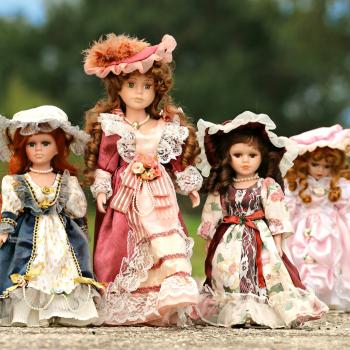It may surprise some readers to know that in spite of my parents’ patriarchal beliefs, they gave one of my brothers a doll for Christmas one year—because he had begged for a doll of his own. My parents believed that my brothers were preparing to be fathers, and that that meant boys playing with dolls was perfectly acceptable.
There’s lots more, too. There’s the brother who built his own dollhouse so that he could get in on dollhouse play with his sisters. He carefully fashioned the rooms, furnishings, and trappings, and was proud of his creation. There’s the brother who wanted to learn to sew, so my mother taught him, and he then went about sewing everyone lopsided but adorable blankets. There’s the brother who was into art, a passion and interest my parents supported with supplies and encouragement.
But there were limits, too. When he was little, one of my brothers had a fascination with a pink ballet leotard with puffy tutu that he found in our dress-up box. He used to wear it around the house, pretending he was a ballerina. There were no objections. Then October came, and he said he wanted to be a ballerina for the fall harvest fest at our church (we didn’t do trick-or-treating, because demons). If I remember correctly, my mother didn’t object. What I remember very clearly, though, is that when my father found out about my brother’s plans he stepped in and put an end to them. My brother was crushed.
I’m not sure why my mother was okay with my brother wearing the ballerina costume when, to this day, she shudders at any mention of LGBTQ individuals. Perhaps because this was over a decade ago, the issue seemed less pressing? Perhaps she never thought of any connection between such childish cross-dressing and being transgender? Mind you, I am not saying that wearing a costume created for the other gender makes one transgender. Kids often don’t notice gender in the same way we do, and this brother has shown no signs of being transgender that I have seen. I’m simply surprised that my mother didn’t object, given her revulsion of LGBTQ individuals.
I suspect I know why my father put the lid on my brother wearing the costume out, though. We were going to be at church, in a semi-public setting, around other people we knew or who knew of us. It’s very likely that heads would have turned at a little boy in a pink ballerina costume.
And so today, I’m curious. Why were certain transgressions of traditional gender norms tolerated while others weren’t? My parents were fine with my brothers, as future fathers, playing with dolls or dollhouses, but they weren’t okay with more direct assaults on these norms, such as my brother dressing as a ballerina for Halloween. And while my mother did teach one of my brothers to sew, it was only that one and only because he asked, and she made an effort to teach each of my sisters whether or not we were interested. Our chores, too, were gendered—we girls generally did the cooking and laundry while the boys generally did outdoor chores.
Musing about my own upbringing makes me wonder about society at large, too. I’ve seen parents wonder whether playing with dolls will make boys grow up to be “soft” (whatever that means) or even gay. I worry that we may be policing the gender lines more strictly today than in the past, especially with how severely gendered advertising to children has become. I’ve heard some argue that companies gender things to make more sales—so that you have to buy a pink one for your girl and a blue one for your boy, rather than just getting one and passing it down—but I wonder if part of the impetus behind gendering things so highly comes from the increasing success marriage equality and an internal concern over what gender means.
I’d like to think that things are getting better on the gender front, but finding an image of a little boy with a doll to use as the featured image for this post was more of a struggle than I’d expected. The first image I chose turned out to be the same one I used with a previous post, so I decided against that one. Ultimately, I found a second picture, but it is from an Italian catalogue of some sort rather than from the U.S. That it was that hard for me to find a picture of a boy holding a doll makes me wonder whether my openly patriarchal parents were more progressive on gendered play than most parents today.
As I’ve written before, my own son has dolls, including one in particular that he always cheers to see. He also has dinosaurs and matchbox cars, and a princess crown. I let my children follow their own interests, including my son. I would hate to think of trying to push his tender soul into some sort of hard exterior of “manly” or “strong” (what does that even mean, anyway?).
I’d rather let kids be kids, and encourage all kids—boys and girls alike—to be persistent, nurturing, and compassionate protectors of those who are smaller or less fortunate.














